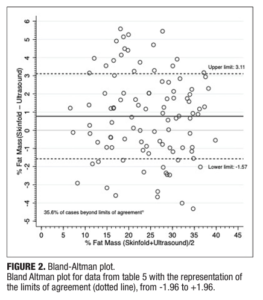HIGHLIGHTS
- Inflammatory bowel diseases are associated with changes in nutritional status.
- Skinfolds measurements and ultrasound are valid methods for assessing body composition and body fat.
- These methods despite comparable are not identical and are useful in clinical nutritional practices in IBD.
ABSTRACT – Background –
Inflammatory bowel diseases (IBD) are associated with important changes in nutritional status. Objective – The aim of the study was to compare body fat composition between two anthropometric methods: skinfolds and ultrasonography, in patients with IBD. Methods – Single-center cross-sectional study with IBD patients in remission or active disease. For the agreement analysis between the body fat assessment methods, the Bland Altman method was used. Results – A total of 101 patients with IBD were included, 75 with Crohn’s disease and 26 with ulcerative colitis. Approximately 56% of the patients with Crohn’s disease and 65.4% of those with ulcerative colitis had a body fat composition above normal levels, with no significant difference between the diseases (P=0.63). The Bland-Altman concordance analysis showed that the methods for assessing the percentage of fat by the adipometer and ultrasound were not in full agreement (P=0.001), despite both presented good correlation (CC 0.961; P=0.000). Conclusion – The analysis of body fat percentage in patients with IBD was different between the skinfolds and ultrasound. Both methods can be used to assess the of body fat percentage of patients with IBD. However, monitoring of body fat sequentially and longitudinally should always be performed using the same method throughout the disease course. Prospective longitudinal studies are warranted to precisely define the role of these two methods of measuring body composition in patients with IBD.
AUTORES
Isadora Sayuri Macedo TUMA, Maria Paula Carlin CAMBI, Thyago Proença de MORAES, Daniéla Oliveira MAGRO and Paulo Gustavo KOTZE.


